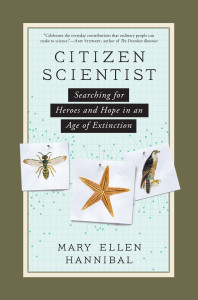In Citizen Scientist, Mary Ellen Hannibal champions everyday citizens, most without formal naturalist training, working to preserve wildlife in their communities.
What can you do to help species in your own backyard (and beyond!)? Here are few tips:
- Get connected.
Anyone with a computer or smartphone can be a naturalist with iNaturalist.org, a global community for recording observations about the natural world. Search iNaturalist’s project database to find specific observation sites in your city. For instance, citizen scientists in Brooklyn can help the NYC Audubon investigate the interaction between “native plants and urban wildlife” in McGolrick Park.
- Pick an animal, plant, or project you’re passionate about.
Love whales? Concerned about what impact the boating industry is having on these giants of the deep?
Become a lookout for Whale Aware, a group that works with citizen scientists to keep whales safe in The Southern California Bight, a spot “frequented by one of the largest populations of marine mammals in the world.
Want to make sure redwood forests thrive for years to come? Join Redwood Watch and help scientists learn more about the plants and animals that depend on them.
- Be a self-starter!
Concerned over the lack of honeybees in your spring garden? Noticed a new species of songbird in your local park?
Now’s the time to search for naturalist organizations in your area who could provide support for your project. Once you’ve got the infrastructure in place, use Scistarter.org to list your project and put out a call for volunteers!
###

To learn more about how you can promote awareness and protect critical species, check out Citizen Scientist. Combining original reporting, meticulous research, and memoir in impassioned prose, Citizen Scientist is a literary event, a blueprint for action, and the story of how one woman rescued herself from an odyssey of loss—with a new kind of science.
Mary Ellen Hannibal is an emerging voice in environmentalism and a sought-after speaker connecting the scientific community to the concerned public. Her writing has appeared in The New York Times, San Francisco Chronicle, Esquire, and Elle, among many others. She is an Alicia Patterson Foundation Fellow and a recipient of the National Society of Science Writers’ Science and Society Award. She lives in San Francisco.


